
International Research Journal of Engineering and Technology (IRJET) e-ISSN:2395-0056 p-ISSN:2395-0072

Volume:11Issue:07|July2024 www.irjet.net



International Research Journal of Engineering and Technology (IRJET) e-ISSN:2395-0056 p-ISSN:2395-0072

Volume:11Issue:07|July2024 www.irjet.net

Dr
Roopali Sood1 , Rudraksh Gupta2
1HOD, Department of Computer Science and Applications, Apeejay College of Fine Arts, Jalandhar, India
2BCA, Department of Computer Science and Applications, Apeejay College of Fine Arts, Jalandhar, India Guru Nanak Dev University, Amritsar, Punjab, India
Abstract - The internet connects linked networks worldwide. It eases data and information flow between different networks. Security issues have grown inimportance as networks exchange data across distant locations. Some individuals exploit the internet for illegal acts like network breaches and fraud. These internet-related crimes go by the name "Cyber Crimes." We hear this term often in news reports due to the rising popularity of online banking and shopping. To combat and penalize cyber criminals, authorities created "Cyber Law." This law governs the web. It forms part of legal frameworks addressing the Internet, cyberspace, and related issues such as online security and privacy. This research conducted by Guru Nanak Dev University student splits into sections to achieve its goals. It presents a quick look at cybercrime's nature, its actors -hackers and crackers, and its various forms. The text also tracks how cyber laws evolved in India.Itsheds light onthese laws' workingsandsuggests ways tofight thishigh-techcrime inIndia. Thechapteraimstogive readers a clear picture of the cybercrime landscape and India's response to it.
Key Words: Cybercrime, Cyber-Security, Hacking, Trojans, Worms, Botnets, Phishing, Keylogger attacks, Brute-force attacks.
Our growing need for the internet has changed how we live and work, making things easier but also more involved. It'sasif we'vesteppedinto a hugedigital space where we can do so much with just a few clicks or taps. Yet, with this ease comes new problems. Think of it as walking down a crowded street in a big town you're surrounded by chances and people, but you also have to keepaneyeoutforthieves,cons,andotherdangers.Inthe digital world, risks come as fake emails that try to trick you into giving away your personal info, malware that locks your data until you pay, or hackers getting into systemstostealimportantinformation.
So,justlikeintherealworld,weneedtobecarefulonline. Itmeansknowing the dangersandactingfirst tokeep our info safe. Using strong passwords, updating software, or beingcarefulaboutwhichlinksweclick-thesesmallsteps canhelpalotinkeepingussafeinourdigitallives.

CYBERCRIME:
It is the use of computers, communication devices, or networkstofacilitateillegalacts.

When we say “cyber”, it is used informally for anything concerningcomputers,ITandvirtualrealities.Thisimplies that“cybercrime”areoffensesrelatedtocomputers,IT,the Internet and virtual realities. A cybercrime is a crime in whichdataandinformationarestolenusingacomputerand theinternet.
There are various examples which owes it’s happening as Cybercrimesuchas-:
Breakingintothegovernmentwebsite.
IdentityFraud.
StealingCreditCardInformation.
RansomwareAttacks.
Theftandsaleofcorporatedata.
Cyberextortion (demanding money to prevent a threatenedattack).
Cyberspying (unauthorized access of governmentorcompanydatabyhackers).


International Research Journal of Engineering and Technology (IRJET) e-ISSN:2395-0056 p-ISSN:2395-0072

Volume:11Issue:07|July2024 www.irjet.net
Cryptojacking (where hackers mine cryptocurrency using the resources they do not own).
We can’t know exactly when cybercrime started or the very first time someone committed a crime over a computernetwork.Thefirstcomputertheftwasin1973,a teller at a New-York bank used a computer to embezzle over2milliondollars.
Thefirstspamemailwasin1978.Sendingspamemailsis a cybercrime. In some countries we can go to jail if we sendspamemails.In1980’sMNCDatabase(pentagonand IDM) was hacked. The first virus was installed on Apple computerswasin1982.
In 1981, Ian Murphy, known as Captain Zap was the first personconvictedofcybercrime. HehackedintotheAT&T network and changed the internal clock to charge offhours rates at peak times. He got 1,000 hours of communityserviceand2.5yearsofprobation.
In1990’sNationalcrackdownoncriminalsandMicrosoft’s NT operating system was pierced. This is where hacking started to become main stream. Before this hacking was verylimitedtoorganization.
In 2001, Cybercriminals attacked eBay, Yahoo, CNN.com, amazonandothers.In2007,Bankwashitbybiggestever hack. Swedish bank, Nordea recorded nearly $1 Million hasbeenstoleninthreemonthsfrom250accounts.
In2013,Adobehad2.9millionaccountscompromisedand their usernames and passwords were released on the open internet. In 2016, Kaspersky: one of the leading antivirus providers to the world reported around 758 millionmaliciousattacksthatoccurred.
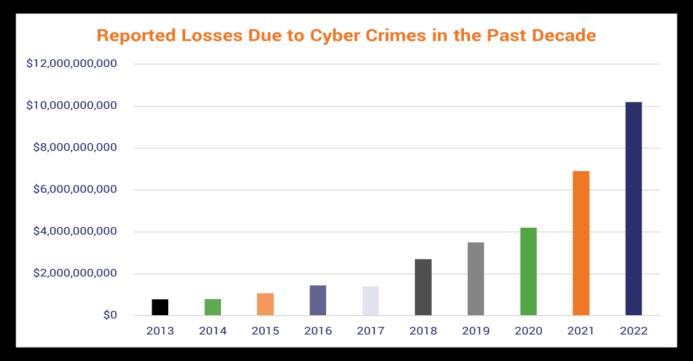


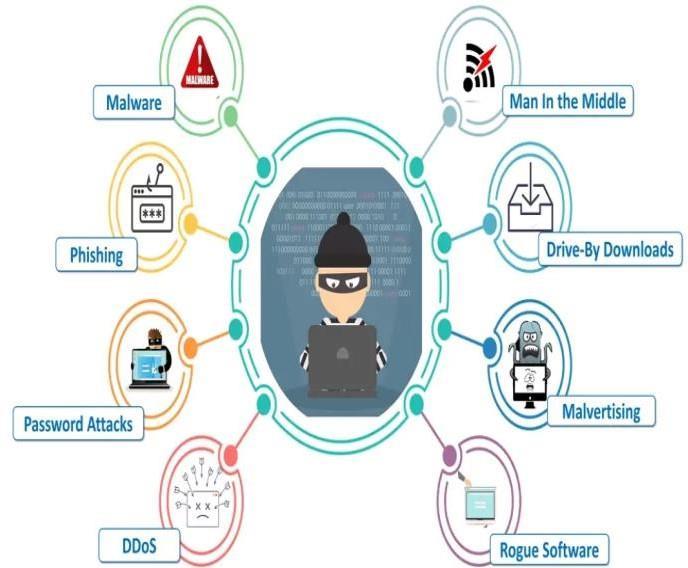
VariousTypesofcybercrime
Malwareisanattackwhereacomputersystemornetwork getsinfectedwithavirusormalware.It’sabroadterm for all types of cyber-attacks including trojans. It’s defined as code with malicious intent that steals data or destroys somethingonthecomputer.
A famous example of a malware attack is the WannaCry ransomwareattackinMay2017.
When WannaCry ransomware hit, 230,000 computers were affected in 150 countries. Users were locked out of their files and a message was sent demanding they pay a Bitcoinransomtogetaccessback.
Many cyber criminals use computer viruses to gain unauthorizedaccesstosystemsandstealdata.Acomputer virus is a malware (malicious software program) loaded intoacomputerwithouttheuser’sknowledge.
5.1.1Trojans:-
Trojan is a kind of malware disguises itself as legitimate software or is included in legitimate software that can be modified. It acts stealthily and creates backdoors in our securitytoletothermalwareenteroursystem.
5.1.2Viruses:-
Owingtoitsname,virusesattachthemselvestocleanfiles andinfectothercleanfilesandcanspreaduncontrollably


Volume:11Issue:07|July2024 www.irjet.net
International Research Journal of Engineering and Technology (IRJET) e-ISSN:2395-0056 p-ISSN:2395-0072

damaging the system’s core and deleting or corrupting files.Theyappearasanexecutablefilethatyoumighthave downloadedfromtheinternet.
5.1.3Botnets:-
Botnets are collections of compromised computers. Designedtocooperateunderdirectionofanattacker.
5.1.4Worms:-
In this, Whole device networks being infected by worms. Local networks or network interfaces used over the internet can help spread it. It makes use of every subsequent compromised system. It spreads more easily andsilently.
Malware may infiltrate our system. If we have open security holes. If we download reputable software from website or if we have corrupted email attachments.
5.2PHISHING
It is type of cybercrime. Perpetrators pretending to be representativesofreputableorganizationscontactvictims via phone email, or messaging. Phishing campaigns involve sending spam emails or other types of correspondence. Intention is deceiving the receivers into taking actions that compromise their own security or security of the company they work for. These fraudsters firstgatherpasswordsandbankaccountinformation. Thentheytakemoney.Phishingmessagesappeargenuine. Theytrytotrickvictimsintodisclosingpersonal information.
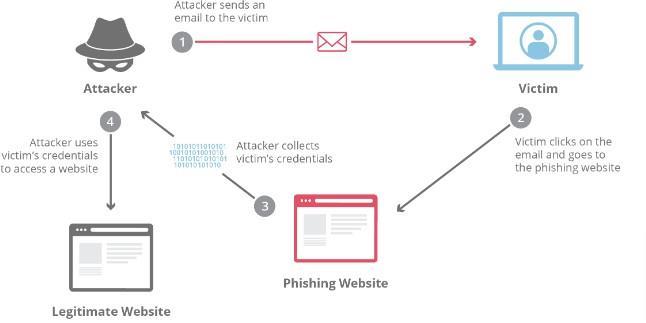
Fig3:ProcessofPhishingattack
The attacker must choose which company to target. They mustfigureouthowtoobtainemailaddressesofthose


companies' clients. After determining which company to impersonate and who their targets are the attackers go through a setup phase. During this time, they develop strategies for sending the messages. They gather data. Finally, they carry out attack. Subsequently, the assailant logs data that victims input into popup windows. Lastly theattackerutilizestheinformationtheyhaveobtainedto commit fraudulent. They commit identity theft transactions.
Cybercriminals utilize distributed denial-of-service (DDoS)assaultsasonekindofcybercrimetoincapacitate systemornetwork.IoTdeviceswithconnectionsareused occasionally.Theattackeremploysthenetworksendlarge amountsofdata.Thisoverwhelminginfluxofdataresults in network experiencing overloading. It is no longer able tooperateeffectively.
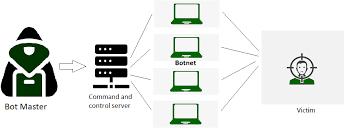
Fig4:DDOSAttack
It is an attempt to obtain the password of a user for the purpose of using it in a malicious manner or decode it. Password attacks used by hackers can include the use of password sniffers, dictionary attacks and cracking software.TheonlyprotectionfromPasswordattacksisto have a policy for passwords which include weekly updates,selectionofrandomwords,andlength.
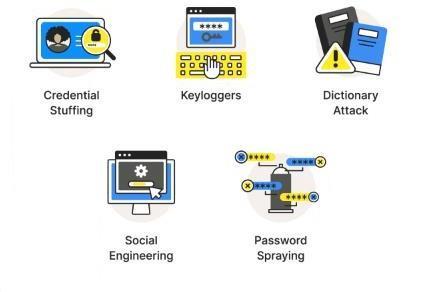
Fig5:CommonTypesofPasswordAttacks
This assault can be done for many reasons, but the most maliciousistogetunauthorizedaccesstoacomputer


Volume:11Issue:07|July2024 www.irjet.net
International Research Journal of Engineering and Technology (IRJET) e-ISSN:2395-0056 p-ISSN:2395-0072

without the consent of the owner of the computer to perform unlawful act such password stealing for bank details.ThereareThreewidelyusedmethodsusedtohack apasswordprotectedsystem.
1) Brute-ForceAttack-: Inthiscase,thehackerlogsin usingacomputerprogramorscriptyguessingthe password onseveral attemptsandthefirst oneis oftenthemostcommon.
2) DictionaryAttacks-:Inthis,hackertriesoversetof commonwordsequenceswithaprogramorascript inanefforttologin.Itonlytriestheattemptsthat are most likely to be successful in the first place; these are normally taken from a list comprising termssuchasdictionaries. Thehumanfactorthat plays a role in these attacks is that individuals choose easy passwords such as their names, birthdatesorothereasilyguessedpasswords
3) KeyloggerAttacks-: Inthis,hackertriestocapture allactionsthattheuserhasentered,includinglogin ID and password, the hacker uses a program to followallkeystrokes.
5.5MANINTHEMIDDLEATTACK
This attack is supported by the end-user and the specific entitywithwhichtheend-userisinteracting.

Fig6:Man-in-the-middleAttack
Forexample,ifwearedoingbankingthroughtheinternet, the man in the middle will be doing the following two things; He will be interfacing with you in as much as he willalsobecommunicatingwithyourbank
Every message that was exchanged between the two parties would instead go to the middle man, and this would in fact mean that such important details as bank account numbers and passwords or any other private informationbeingpassedaroundwould reachthemanin themiddle.


5.5.1ManinthemiddlePrevention
Usingfollowingstepscanhelptopreventthesetypeof crime-:
1) Employencryptedwirelessaccesspoints(WAPs).
2) It is important always to check whether the connectionissecure(HTTPSorHSTS)before proceedingwithconnection.
3) SpendonhighsecuredVPN
DRIVE-BY Download: This attack targets vulnerable machineswhentheyconnecttoawebpagecontainingthis assault.
This kind of attack has been identified as the leading web security threat in the current world, based on the recent MicrosoftSecurityIntelligenceReport.
Roguesoftwareisalsoknownasfrauds securityorscam security. Its goal is to have an adverse impact or modify computersettingsinanadversemanner.Inthisinstance, it will convince you to spend some money using your creditcardbesideseffectingchangesinthesystem.

Fig7:RogueDHCPServerAttack
Differentwaysoftrickingandscammingpeopleare-:
1) Hacking: - It is the act of identifying and then exploitingweaknessesinacomputersystemor network,usuallytogainunauthorizedaccessto personalororganizationaldata.
2) Identity Theft: - It is referred to as a type of cybercrimeinwhichcriminalsstealunauthorized and important personal information like passcodesandbank-accountdetails.
3) Software Piracy: - Software piracy is the unauthorized use, copying or distribution of copyrighted software. It may take many forms, including: Unauthorized copying of software programs purchased legitimately, sometimes knownas"end-user"piracy.Gainingillegalaccess toprotectedsoftware,alsoknownas"cracking"
4) Credit-CardFraud: -Itistheformoffraudthat involvesanunauthorizedtakingofanother's


Volume:11Issue:07|July2024 www.irjet.net
International Research Journal of Engineering and Technology (IRJET) e-ISSN:2395-0056 p-ISSN:2395-0072

credit card information for the purpose of charging purchases to the account or removing fundsfromit.
InformationSecurityisanactivity,whichcouldbepossibly performed by, to keep and protect Information and other related communications from stealing and misuse, tampering,andmaliciousact.
6.1Thefollowingaresomeprecautionswhichwecan taketopreventcybercrimeactions:
1) Ensure Software and operating systems are updated: -Whenthesecomponentsareupdated, itensuresyou have the latestsecurity update to protectyourcomputer.
2) ControllingtheSocialMediasettings: -Protect oneself from personal and private information. Social engineering hackers can most of the time, get our personal details with even little details. Forinstance,youmightgetinthehabitofposting thenameofyourpet,thusrevealingtheanswers tocommonsecurityquestions.
3) UsingUpdatedAnti-Virussoftware: -Updated antivirus software can help and secure our computer to various trojans and malware that affectoutdataandinformation.
4) Use secure passwords: - Be particular while comingupwithpasswordtoensuretheyarehard for other people to guess and ensure you do not disclose them. To ease this, you can also use a reliable password generator from a password managerandcreatethesepasswordsatrandom.
5) Do notclick onlinksin unsolicited emails or websites: - Opening links in emails or other messages that people receive or links found on theinternetingeneralisanotherwaypeopleare caughtwithcybercrime.
6) Pay attention to the URL’s one is visiting:EnsurethattheURLsyouarechoosingarewellcaptured. Do not click on links that seem to be spamoryoudidnotexpecttoseethem.
Usingofpublicnetworksshouldbe avoided
Utilizing public computers for financial transactionsshouldberefrainedbyuser.
Neverdivulgeyourpasswordstooutside parties.
Refrainfrominstallingunidentifiedapps onyourPC.
Emailisnowregardedasalegitimateand authorizedmeansofexchangeofideas.


TheActgrantslegallegitimacytodigital signatures.
TheActestablishednewcorporateentitiesknown astheCertifyingAuthorities,whoarenowableto issuedigitalcertificates.
Throughe-governance,thisActenablesthe governmenttopostnoticesonline.
Theinternetisnowameansofcommunicationfor businesses as well as between them and the government.
Theinternetisnowameansofcommunicationfor businesses as well as between them and the government.
The Act offers the corporation financial compensationasaremedyintheeventthat criminalscauseitanylossorharm.
InadditiontotheSectionsundertheIPCandITAA, 2008,theIndiangovernmenthasimplementedthe followingmeasurestodetercybercrimes:
StatesandU.T.shaveestablishedcybercrime units to record and look into cybercrime incidents.
Inaddition,thegovernmenthasestablished Cyber Forensics and Training Labs in the states of Kerala, Assam, Mumbai, Mizoram, Manipur,Nagaland,ArunachalPradesh,etc. undertheITAct,2000,withthepurposeof raising awareness and providing training against
For the purpose of raising awareness and providingtraining,NASSCOM,CyberForensic Labs, and the Data Security Council of India (DSCI) have established Cyber Forensic Labs inMumbai,Bengaluru,Pune,andKolkata.
Cybersecurity is the practice of protecting systems, networks, and programs from digital attacks. These cyberattacks are usually aimed at accessing, changing, or destroying sensitive information; extorting money from users via ransomware; or interrupting normal business processes.
USAGE:
1.Safeguardingthecompany. 2.Enhancedoutput 3.Encouragestrustfromcustomers. 4.Preventsthewebsitefromcollapsing. 5.Safeguardingtheclientsorcustomers.


Volume:11Issue:07|July2024 www.irjet.net

Cybersecurityisneededtodayaspeople store, transmit, and process their personal and financial information, businesssecrets,andcrucial infrastructure’s data in the cyberspace. Malicious attacks are dangerous and can lead to monetary loss, tarnishing of companies’ images, and in some cases, lossoflife.
cyber security remains crucial in any organization irrespective of the nature andsizeoftheorganization.Theincrease intechnologyandinturntheincreasein software in the governmental, educational and hospital sectors lead to information going digital through wirelesscommunicationnetworks.
The significance of cyber security is to protect the information of different organizations such as e-mail, yahoo and many more, that have such confidential datawhichifleaking,canresulttolosses to both parties and tainted reputations. Evil doers focus on the small and big firmsandacquirethe papersthatareof importance.
Security as a whole has greatly become an important aspect especially in the contemporary society with the internet andotherrelatedtechnologies.Duetothe increased storage and transmission of data,thecasesofcybercriminalattacksin organizationshavealsocontinuedtorise. Cyber security is a way of safeguarding computers as well as their networks, hardware, software, data and digital informationandassets.
8.2TECHNIQUESUSEDINCYBERSECURITY
Cybersecuritytechniquesareusedbyallinday-to-daylife suchas-:
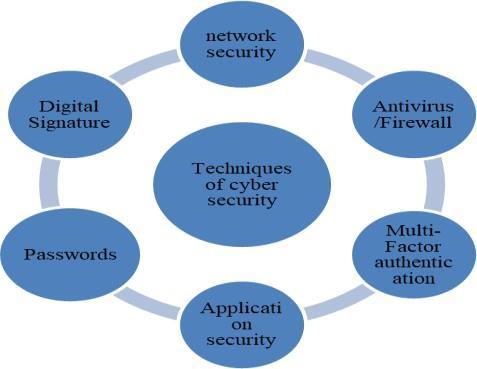

p-ISSN:2395-0072

Firewalls: It act as a barrier between a trusted internal network and untrusted external networks. They filter incoming and outgoing traffic based on predetermined security rules. Firewallscanbehardware-based,software-based, oracombinationofboth.
Multi-Factor Authentication (MFA): MFA requiresuserstoprovidetwoormoreverification factors to gain access to a resource. This might include something they know (password), something they have (security token), and somethingtheyare(biometricverification).
Application Security: Application security encompassesmeasures toimprovethesecurity of an application often by finding, fixing, and preventingsecurityvulnerabilities.
Passwords: Passwords are the most common formofauthentication,requiringausertoprovide a secret string of characters to gain access to a system. Enforcing strong password policies (complexity, length), regular password changes, usingpasswordmanagers,andavoidingthereuse ofpasswordsacrossdifferentplatforms.
Digital Signature: A digital signature is a mathematical scheme for verifying the authenticityandintegrityofdigitalmessagesor documents. Utilizing public key infrastructure (PKI) to create and verify signatures, ensuring non-repudiationandauthenticityofdocuments andcommunications.
Network Security: Network security involves measures taken to protect the integrity, confidentiality, and availability of computer networks and data using both software and hardware technologies. Firewalls, Intrusion Detection Systems (IDS), Intrusion Prevention Systems(IPS),VirtualPrivateNetworks(VPNs), andsecurenetworkprotocols.
Cybersecurityinvolvesbroadrangeofdomainssuchas:
AssetSecurity.
SecurityArchitectureandEngineering.
CommunicationandNetworkSecurity.
Identityandaccessmanagement.
Securityoperations.
SecurityassessmentandTesting.
SoftwaredevelopmentandSecurity.
Securityandriskmanagement


International Research Journal of Engineering and Technology (IRJET) e-ISSN:2395-0056 p-ISSN:2395-0072

Volume:11Issue:07|July2024 www.irjet.net
Indeed, the internet is widely used in the present day and age to the extent of being a formidable tool that dictates how lives are lived, tasks are accomplished, and people relate. With that said, we continue to engage in this environment, and now the protection of one’s data has never been more vital. The best thing that can be implemented todayis theability tolivea securelifeonline by adhering to cybersecurity concepts. By understanding and applying these principles, we can navigate the digital worldwithconfidenceandpeaceofmind.

2) https://www.indiacode.nic.in/bitstream/12345 6789/13116/1/it_act_2000_updated.pdf
3) Bar Association of India (2015). Anti-Bullying
1) Brenner, W. Susan (2010). Cybercrime: Criminal threats from cyber space. Green Wood Publishing Group,Westport LawsinIndia.Retrievedfrom
4) Anderson, T. M. & Gardener, T.J. (2015). Criminal Law: Twelfth Edition. Stanford, CT: CengageLearning.
5) UganderGJReddy,NikhitaReddyGade(2014). A Study of Cyber Security Challenges and Its EmergingTrendsonLatestTechnologies
6) https://www.cisco.com/c/en_in/products/securi ty/what-is-cybersecurity.html
7) https://www.geeksforgeeks.org/cyber-securitytypes-and-importance/

